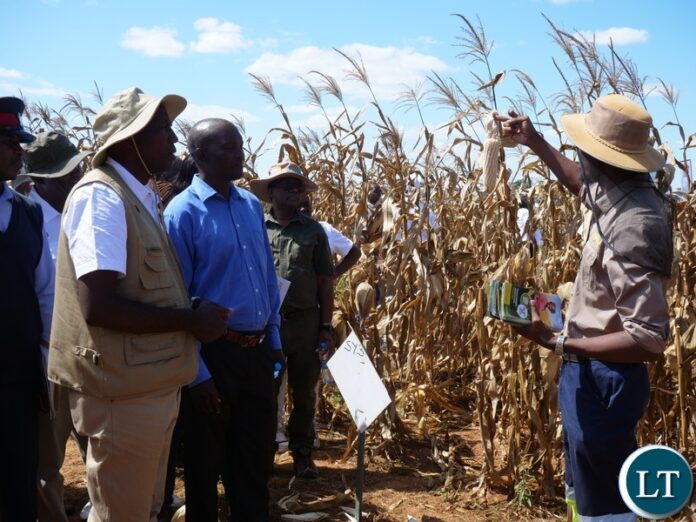… stakeholders moot aggressive plan to grow cotton, improve yield, empower farmer
By Benedict Tembo
A little more than two decades ago, cotton was widely cultivated in Zambia and had healthy financial returns for farmers.
It was one of the most attractive cash crops especially in traditional agricultural provinces such as Central, Eastern and Southern provinces.
But a drastic drop in prices, which are dictated by buyers, coupled with labour intensity, has forced farmers to migrate to more profitable cash crops such as soybean, in addition to maize.Fred Mooya is saddened that cultivation of cotton has been on a decline in Ngwezi settlement in Magoye, Mazabuka District.
Mr Mooya, who represented Chief Hanjalika during the 2025 Cotton Field Day at the Cotton Development Trust (CDT) in Magoye on Tuesday, said Ngwezi was once the hub of cotton production but there has been a steep decline in cotton and this has contributed to increase in poverty levels.
“There is a very big decline,” he said, pointing to lack of favourable policies as local people are no longer seeing the economic value of growing the crop.
“Cotton buyers dictate the price. [Hence], very few farmers are growing cotton,” Mr Mooya said.
He said cotton was a good cash crop but poor prices have discouraged most farmers who have switched to cultivating maize for consumption and sale to the Food Reserve Agency.
“Cotton growing is labour intensive, at the end of the day, they get peanuts. The price of maize is good while the price of cotton is poor. Lint is very light and needs huge quantities to make a 25 kilogramme bag,” Mr Mooya said.The field day was held under the theme” Driving Cotton Excellence: Innovations, Partnerships, and Farmer Empowerment.”
Yet, cotton is Zambia’s second most important crop after maize, providing livelihoods for over 300,000 farming households.
But despite favourable agro-climatic conditions and strong farmer participation, the sector has been facing structural challenges: low productivity, declining yields, obsolete equipment, inadequate extension support, and weak cotton prices.
However, the plight of cotton farmers could be a thing of the past going by the technical and legal reforms going on in the sector.
Zambia and Brazil have signed a three-year Strengthening of the Cotton Value Chain in Zambia project,implemented under a South-South cooperation framework which is designed to boost the performance,sustainability, and competitiveness of Zambia’s cotton sector.
The project designed to leverage Brazil’s expertise in cotton research and extension, built through successful initiatives in Africa such as the Cotton-4 (Benin, Burkina Faso, Chad, and Mali), to deliver transformative technical cooperation, is now taking shape at the CDT in Magoye.
The Brazilian Cooperation Agency (BCA), which is implementing the project along with its lead the lead partners, the Agricultural Research Company of Minas Gerais (EPAMIG), and the Technical Assistance and Rural Extension Company of Minas Gerais (EMATER-MG), has set up a Technical Demonstration Unit at CDT under the guidance of the African Union.
The development goal of the project is to contribute to Zambia’s Gross Domestic Product growth through improved performance in the cotton sector.The specific goals are to increase cotton yields and competitiveness in Magoye.
Melissa Popoff Scheidemantel, the BCA project analyst some of the activities include capacity building and institutional strengthening by training of extension agents, researchers, and lead farmers.Apart from technology transfer and demonstrations, Ms Scheidemantel said there will also be exchange of visits between Zambian researchers and Brazilian researchers.
She said the exchange visits have already started.
"We had a Zambian team for technical visits in Brazil last year. The trip to Kenya already took place in April. It is part of the activities foreseen in a Regional Project we have with 15 countries that are part of the Brazilian Programme to improve Cotton Production in Africa, " Ms Scheidemantel said. She said Zambian researchers took part in a course on pesticide application.
Ms Scheidemantel said three Zambian representatives recently travelled to Kenya.Kenya is one of the countries that benefit from the Brazilian Programme to Improve Cotton Production in Africa,Martin Simasiku, the CDT cotton breeder, said apart from the setting up of a Technical Demonstration Unit at CDT Magoye, there will also be validation and local adaptation of Brazilian cotton planting protocols.
Mr Simasiku said the project will also facilitate the implementation of pest identification and integrated management training.
He said the expected results are improved cotton yields and quality in pilot regions, strengthened extension and research capacities, enhanced farmer organisation and productivity, operational demonstration plots and validated technologies as well as the adaptation of Brazilian methods to Zambia’s farming realities.
Speaking at the TDU site, CBZ chief executive officer Raymond Mpundu said people who attended the field day were just having a glimpse of what will happen next year when the cooperation takes effect.Mpundu spoke about the ongoing reforms to make the cotton sector profitable, which include repealing the 2005 Cotton Act which has become obsolete.
Under the new Act, the CBZ will set the cotton prices instead of the cotton buyers. He said this will protect the farmers and other stakeholders from abuse.On the technical side, Mr Mpundu said farmers will be receiving minimum cotton production packages which will make their trade profitable.



If you want cotton to regain its value speak to your first lady Mutinta who thinks she must buy bales of salaula and donate them to folk in rural Zambia.
Cotton wont appeal to an industry competing against salaula in a market disturbed by the low price of second hand clothes. Salaula degrades citizens pride and any leader who wants his nation to be PROUD and FREE in a land of work and joy in unity would do everything to discourage it. Trump would have put heavy tariffs on salaula but your HH thinks as long as it buys him votes ni fikaisova.
Comments are closed.